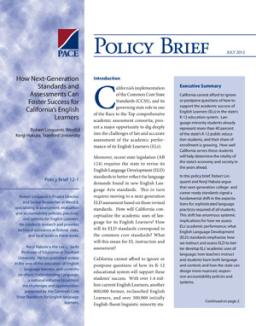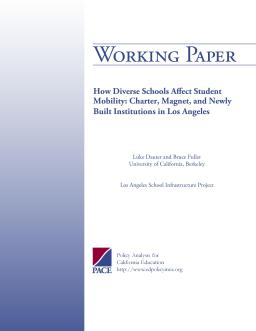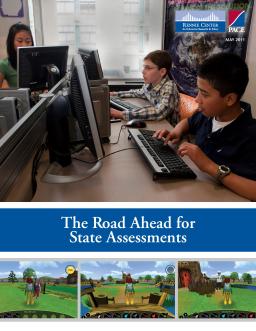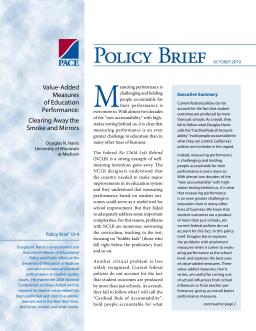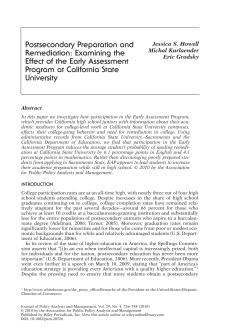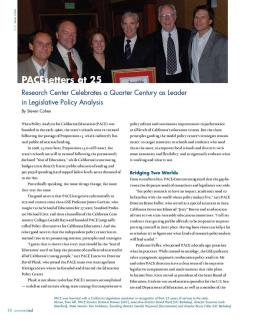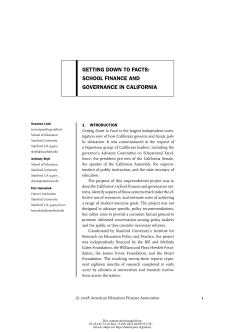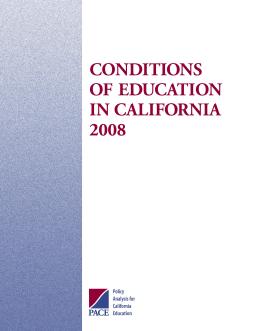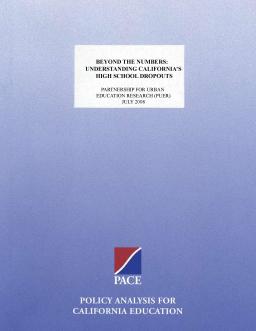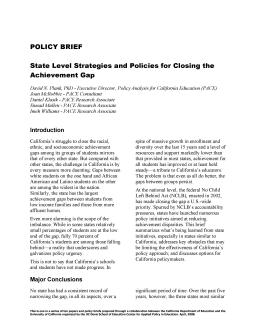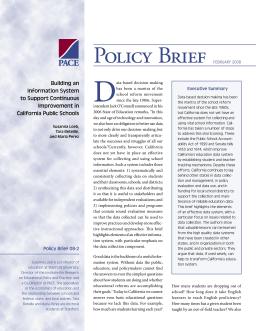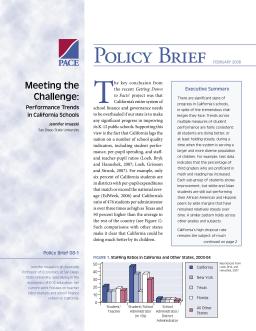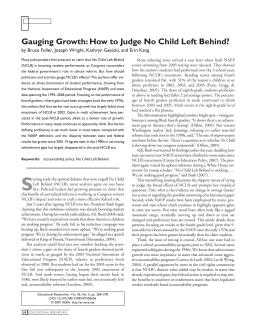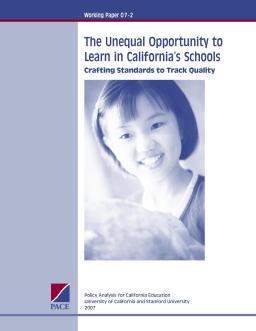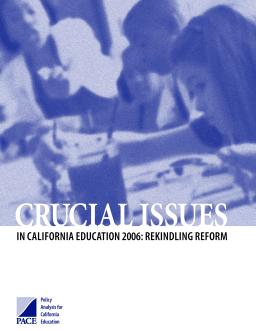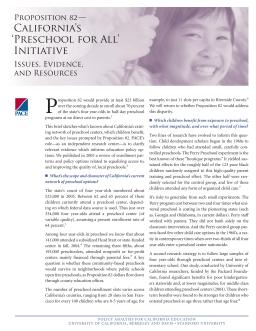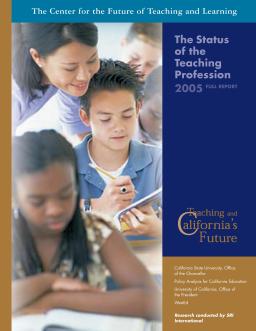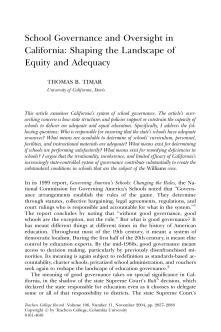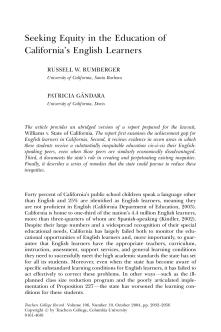Published
Summary
California cannot afford to ignore or postpone questions of how to support the academic success of English Learners (ELs) in the state’s K-12 education system. Language-minority students already represent more than 40 percent of the state’s K-12 public education students, and their share of enrollment is growing. How well California serves these students will help determine the vitality of the state’s economy and society in the years ahead.
Five Years Later
Published
Summary
This report commemorates the fifth anniversary of the Getting Down to Facts project, which sought to provide a thorough and reliable analysis of the critical challenges facing California’s education system as the necessary basis for an informed discussion of policy changes aimed at improving the performance of California schools and students. The report focuses on the four key issues that received emphasis in the Getting Down to Facts studies: governance, finance, personnel, and data systems.
From Governance to Capacity Building
Published
Summary
Education reform efforts in Los Angeles and the US have failed due to the focus on governance and rules. The solution is to invest in capacity building, creating incentives and agency for students and teachers, easing adoption through regulatory relief, and financing those working on new learning models. The goal is to update the century-old model of learning, called Learning 1.0, with a new model, Learning 2.0, that builds an education system around the learning system. This approach is based on research into unconventional learning models.
Charter, Magnet, and Newly Built Campuses in Los Angeles
Published
Summary
This paper examines the impact of pupil mobility in urban districts like Los Angeles, where families are encouraged to switch schools due to the growth of mixed-markets of charter, magnet, and pilot schools. African American and White students are more likely to exit their schools, while overcrowding in low-income Latino neighborhoods leads to higher exit rates. Charter and magnet school students exit less. The district's commitment to relieve overcrowding leads to Latino students moving to newly built schools. The opening of new high schools reduced pupil mobility.
Published
Summary
This report provides policy guidance for new state assessments aligned to Common Core State Standards. It aims to inform the work of the two consortia funded by the U.S. Department of Education in developing the assessments. The report includes three papers addressing issues of computer adaptive assessments, assessment of English learners, and assessing science. The authors' vision of new assessments goes beyond the horizon of current practice and emphasizes the need to use new technologies to provide useful and timely information to students and teachers.
Clearing Away the Smoke and Mirrors
Published
Summary
This brief examines the strengths and weaknesses of value-added measures, which are useful for separating out school influences from other factors when evaluating teacher and school performance. Although value-added assessments give a summative picture of teacher performance, they do not provide guidance on how to improve. The author explores best uses and practices for value-added measures and discusses the limitations of attainment measures in evaluating school performance. The "Cardinal Rule of Accountability" is to hold people accountable for what they can control.
Examining the Effect of the Early Assessment Program at California State University
Published
Summary
This study analyzes the impact of the Early Assessment Program (EAP) on the college-going behavior and remediation needs of California high school juniors. Results show that EAP participation reduces the need for remediation at California State Universities by 6.1 percentage points in English and 4.1 percentage points in mathematics. The program does not discourage poorly prepared students from applying to college but rather encourages them to increase their academic preparation in high school.
Published
Summary
This brief examines the use of student test scores in teacher evaluations in CA. It argues that current evaluation methods are not effective, and that alternative methods of measuring teacher effectiveness, such as peer evaluations and student surveys, should be explored. The brief also discusses the potential consequences of over-reliance on test scores, such as teaching to the test and neglecting non-tested subjects. It concludes that teacher evaluations should be designed to provide useful feedback for professional development, rather than being used solely for accountability purposes.
Research Center Celebrates a Quarter Century as Leader in Legislative Policy Analysis
Published
Summary
The call for improved education persists annually within PACE, emphasizing the perpetual need for progress. Even with strides made, the organization does not consider its mission accomplished. Guided by three core principles—allocating resources to disadvantaged schools, granting autonomy to local districts, and rigorous evaluation of educational efficacy—PACE remains dedicated to fostering lasting policy reform and enhanced educational performance across California's system. Leveraging experience from Michigan State's Education Policy Center, PACE's leadership continues to drive the...
School Finance and Governance in California
Published
Summary
Getting Down to Facts is an extensive investigation of CA's public education system commissioned by a bipartisan group of CA leaders. The project aimed to describe California's school finance and governance systems, identify obstacles hindering resource utilization, and estimate costs to achieve student outcome goals. The project resulted in 23 reports by scholars, which highlight that the current school finance and governance systems fail to help students achieve state performance goals, particularly those from low-income families. The reports provide a framework for assessing reform options.
Published
Summary
PACE is bringing back its publication, Conditions of Education in California, to keep the focus on the long-term education reforms required by California. Six policy scholars have contributed to this edition, providing baseline data on school performance and recommendations for policy changes to support long-term improvement. PACE plans to continue regular publication of this report to track progress towards a more effective educational system in California.
Understanding California's High School Dropouts
Published
Summary
The Partnership for Urban Education Research (PUER) comprises six of California's largest urban school districts working together to increase data availability, enhance internal research capacity, and promote collaboration and information sharing across district lines to benefit students. In a new report, PUER districts identified opportunities to improve the current dropout reporting system and reviewed district efforts to reduce dropout rates. PUER is working with PACE to review and publish their research.
Published
Summary
California faces significant challenges in closing the achievement gap between different student groups, including wide disparities based on race, ethnicity, and socioeconomic status. While progress has been made, the gaps persist. This report summarizes what is being learned from state initiatives to reduce these disparities, addresses obstacles limiting effectiveness, and provides options for policymakers to address this urgent issue.
Published
Summary
California needs to improve its education data system to collect and use vital school information for continuous improvement. The state is behind in data collection, management, evaluation, and funding compared to other states. The report suggests learning from other high-quality data systems and using data to transform California's education system.
Performance Trends in California Schools
Published
Summary
California's education system faces financial and demographic challenges, with per pupil spending below the national average and a majority of students living in poverty or English Learners. However, recent state and national assessments show improved academic performance, particularly for poor and minority students. More students are taking advanced math and science courses and meeting university admission requirements. While the state falls short of its goals, systemic reforms are needed, but the gains are a result of hard work and commitment from California's educators.
Data Systems and Policy Learning
Published
Summary
This report advocates for a continuous improvement approach to education in California, emphasizing the need for a comprehensive data system to inform decision-making and evaluation at all levels of the education system. It also recommends the use of research-based practices and the development of partnerships between schools and community organizations to support student success. The report emphasizes the importance of equity and suggests strategies for addressing achievement gaps and providing more resources to under-resourced schools.
How to Judge No Child Left Behind?
Published
Summary
This report analyzes the effects of No Child Left Behind (NCLB) on student performance using three barometers: the National Assessment of Educational Progress (NAEP), state data, and fourth-grade test scores. The authors find that earlier test score growth has largely faded since NCLB's enactment in 2002, and progress made in narrowing achievement gaps in the 1990s has largely disappeared in the post-NCLB era. The report suggests that policymakers need to reconsider the efficacy of NCLB and consider alternative approaches to school reform.
Crafting Standards to Track Quality
Published
Summary
This paper investigates the effects of class size reduction (CSR) on student achievement in California's K-3 classrooms. Using data from the state's Standardized Testing and Reporting program, the authors find that smaller class sizes improve student achievement in English-language arts and have a stronger effect on low-income and minority students. However, the authors caution that the full benefits of CSR may be realized only with sustained implementation, quality teaching, and alignment with curriculum and instructional strategies.
Rekindling Reform
Published
Summary
This report discusses key education policy challenges in California, including funding, teacher quality, achievement gaps, and school accountability. The report highlights the need for equitable funding and effective teacher training and retention programs to address these issues. It also emphasizes the importance of holding schools accountable for student achievement and providing targeted support to struggling schools. The report concludes by calling for sustained attention to these critical education issues to ensure that all California students have access to a high-quality education.
Issues, Evidence, and Resources
Published
Summary
This brief provides an overview of California's existing network of preschool centers and the potential impact of Proposition 82, which would provide funding for half-day preschool programs for 70% of the state's four-year-olds. PACE, an independent research center, aims to clarify evidence informing education policy options. A 2005 PACE review focused on enrollment patterns and policy options for improving access and quality of local preschools.
The Reliability of How States Track Achievement
Published
Summary
This paper analyzes the impact of the No Child Left Behind Act on the state's funding system and notes that it exacerbated inequities by penalizing schools that did not meet annual progress targets without providing sufficient resources to help them improve. The authors suggest that a more equitable funding system based on student needs and costs would better serve all students, including those who are struggling to meet academic standards.
Full Report
Published
Summary
The Teaching and California's Future initiative provides policymakers with data on the teacher workforce and labor market. The initiative's annual report details teacher development policies and their impact on teacher quality and distribution. The goal is to help policymakers make informed decisions about strengthening the state's teacher workforce.
Published
Summary
The quality of teaching and the need to expand California's ranks of excellent teachers demand urgent public discussion. We must attract the best and brightest to teaching, prepare them effectively, and support and retain them. Solutions require bipartisan leadership, not spin. This report presents the latest research and projections, highlighting that while some numbers are improving, we're likely to face severe shortages again soon and the pipeline for recruiting, preparing, and training teachers has substantial problems.
Shaping the Landscape of Equity and Adequacy
Published
Summary
This report focuses on California's school governance system and how it affects schools' ability to provide an adequate and equal education. The author examines who is responsible for ensuring adequate resources, how to assess adequacy, how to determine school performance, and how to address deficiencies. The report argues that California's state-controlled governance system is irrational, incoherent, and limited in efficacy, contributing to substandard school conditions, as seen in the Williams v. California case.
Published
Summary
This article presents a summary of a report prepared for the Williams v. State of California lawsuit, highlighting the achievement gap for English learners in California and seven areas where they receive an inequitable education compared to their English-speaking peers. It also documents the state's role in perpetuating these inequities and proposes remedies to reduce them.
